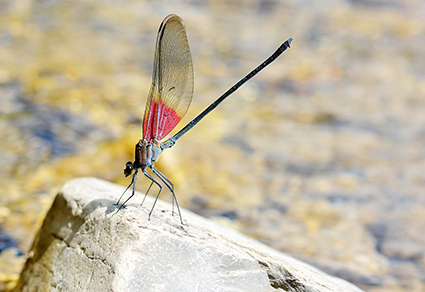Abstract
The final instar larva of the genus Archineura Kirby, 1894 is described for the first time, based on a specimen of the Chinese endemic species Archineura incarnata (Karsch, 1892) collected from Mt. Nankunshan, Guangdong Province, China. The larva is distinguished by several characters, including its moderately slender build combined with the distinctive extremely long legs, long, narrow, uniquely spined outer caudal appendages, a mask strongly expanded anteriorly with a relatively small median cleft, and robust spines at the apex of the labial palp. The mask is most similar to larvae of Echo Selys, 1853, Mnais Selys, 1853 and Psolodesmus MacLachlan, 1870 which are considered its nearest relatives based on molecular analysis, but from which it differs in other characters. The biology of Archineura larvae is discussed briefly.
References
Dumont, H.J., Vierstraete, A. & Vanfleteren, J.R. (2007) A revised molecular phylogeny of the Calopteryginae (Zygoptera: Calopterygidae). Odonatologica, 36 (4), 365–372.
Chen, J. & Yu, X. (2013) Odonata diversity of the middle and lower reaches of the Red River basin, Yunnan, China. Journal of Insect Biodiversity, 1 (9), 1–11. https://doi.org/10.12976/jib/2013.1.9
Fraser, F.C. (1943) New oriental Odonata larvae. Proceedings of the Royal entomological society, London, Series B, 12 (5/6), 81–93. https://doi.org/10.1111/j.1365-3113.1943.tb00749.x
Guan, Z., Han, B.P., Vierstraete, A. & Dumont, H.J. (2012) Additions and refinements to the molecular phylogeny of the Calopteryginae s.l. (Zygoptera: Calopterygidae). Odonatologica, 41 (1), 17–24.
Hämäläinen, M. (2015) From Echo maxima to Archineura maxima–a slow taxonomic process (Odonata: Calopterygidae). Notulae odonatogica, 8 (6), 157–201.
Ishida, K. (1996) Monograph of Odonata larvae in Japan. Hokkaido University Press, Sapporo, pp. 157–161.
Lieftinck, M. (1965) The species-group of Vestalis amoena Selys, 1853, in Sundaland (Odonata, Calopterygidae). Tijdschrift voor Entomologie, 108 (11), 325–364.
Matsuki, K. & Lien, J.C. (1978). Descriptions of the larvae of three families of Zygoptera breeding in the streams of Taiwan (Synlestidae, Euphaeidae, Calopterygidae). Tombo, Tokyo, 21, 15–26.
Orr, A.G. & Price, B.W. (2022) A description of the larva of Matronoides cyaneipennis Förster, 1897 from northern Borneo (Odonata: Calopterygidae). Odonatologica. [in press]
Paulson, D., Schorr, M. & Deliry, C. (2022) World Odonata List. Available from: https://www2.pugetsound.edu/academics/academic-resources/slater-museum/biodiversity-resources/dragonflies/world-odonata-list2/ (accessed 7 April 2022)
Watson, M.C. (1956) The utilization of mandibular armature in taxonomic studies of anisopterous nymphs. Transactions of the American Entomological Society, 81, 155–202.
Yang, G.-H., Zhang, H.-M. & Orr, A.G. (2021) Descriptions of larvae of Caliphaea angka Hämäläinen, 2003 and Mnais gregoryi Fraser, 1924 (Odonata: Calopterygidae). Zootaxa, 4926 (2), 276–284. https://doi.org/10.11646/zootaxa.4926.2.7
Zhang, H.-M. (2019) Dragonflies and Damselflies of China. Chong Qing University Press, Chong Qing, pp. 952–958.


